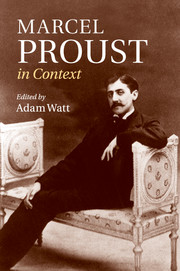Book contents
- Frontmatter
- Contents
- List of Illustrations
- Notes on contributors
- Figure I. Marcel Proust, portrait in oils by Jacques-Émile Blanche, 1892
- Preface
- Figure 2. Proust photographed on his death-bed by Man Ray, 1922
- Note on the text
- Chronology
- Part I Life and works
- Part II Historical and cultural contexts
- i. The arts
- ii. Self and society
- Chapter 14 Freud and psychoanalysis
- Chapter 15 Sexuality
- Chapter 16 Health and medicine
- Chapter 17 Technology and science
- Chapter 18 Religion
- Chapter 19 Travel
- Chapter 20 Journalism
- Chapter 21 Politics and class
- Chapter 22 The Dreyfus Affair
- Chapter 23 The First World War
- Part III Critical reception
- Further reading
- Index
- References
Chapter 19 - Travel
from ii. - Self and society
Published online by Cambridge University Press: 05 November 2013
- Frontmatter
- Contents
- List of Illustrations
- Notes on contributors
- Figure I. Marcel Proust, portrait in oils by Jacques-Émile Blanche, 1892
- Preface
- Figure 2. Proust photographed on his death-bed by Man Ray, 1922
- Note on the text
- Chronology
- Part I Life and works
- Part II Historical and cultural contexts
- i. The arts
- ii. Self and society
- Chapter 14 Freud and psychoanalysis
- Chapter 15 Sexuality
- Chapter 16 Health and medicine
- Chapter 17 Technology and science
- Chapter 18 Religion
- Chapter 19 Travel
- Chapter 20 Journalism
- Chapter 21 Politics and class
- Chapter 22 The Dreyfus Affair
- Chapter 23 The First World War
- Part III Critical reception
- Further reading
- Index
- References
Summary
The only real journey . . . would be to travel not towards new landscapes, but with new eyes, to see the universe through the eyes of another, of a hundred others.
(5: 237; iii, 762)Banality is never in the world. It is always in the gaze.
The interconnectedness of space, place, modernity and desire in Proust has preoccupied critics from Georges Poulet to Sara Danius, but little attention has been granted to Proust's relationship to contemporary cultures of travel and to the theories of travel that evolved in the course of the twentieth century. Yet the striking overlap between his observation above and that of contemporary travel theorist, Jean-Didier Urbain, also establishes Proust as a time-traveller. In the period between Proust's and Urbain's aphoristic comments, writers as diverse as Georges Perec, Henri Michaux and cultural anthropologist Claude Lévi-Strauss were, with differing inflections, pronouncing or implying ‘la fin des voyages’. With a sense of exhaustion of the possibilities of geographical exploration, each was calling for, or enacting, a form of virtual travel based on a freshness of perception, a willingness to see the world differently. As Urbain continues:
What is important is not whether (or not) the world is ‘washed of its exoticism’ [‘rincé de son exotisme’], but whether it might one day be perceived as such. Whether it is ‘washed’ or not, what is essential is surely to rid oneself of this disagreeable impression and to reinvent the exoticism of the world.
- Type
- Chapter
- Information
- Marcel Proust in Context , pp. 145 - 152Publisher: Cambridge University PressPrint publication year: 2013

